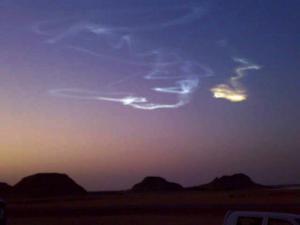
© Mohamed Elhassan Abdelatif Mahir/Noub NGO/Muawia H Shaddad/U Khartoum/Peter Jenniskens/SETI Institute/NASA Ames)The small asteroid 2008 TC3 broke up in the atmosphere above Sudan on 7 October and left behind this wind-blown trail high in the sky.
The discovery of meteorites from an asteroid that exploded over Sudan in October completes an astronomical trifecta. For the first time, scientists have detected a space rock ahead of a collision with Earth, watched it streak through the atmosphere, and then recovered pieces of it. Analysis of the meteorites could shed light on conditions in the early solar system more than 4 billion years ago.
When the
asteroid, called 2008 TC3, was discovered on 6 October last year, it was just 20 hours away from hitting Earth. Though the warning period was short, it was the first time a space rock had been found before it impacted the planet.
Orbital calculations predicted the object would plunge into the atmosphere above Sudan at 0246 GMT on 7 October, and it arrived right on time. Observations suggested it was no more than 5 metres across, too small to survive intact all the way to the ground and cause damage.

Comment: Here's info on the Texas fireball in case you missed it.